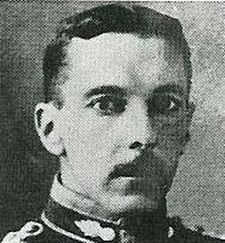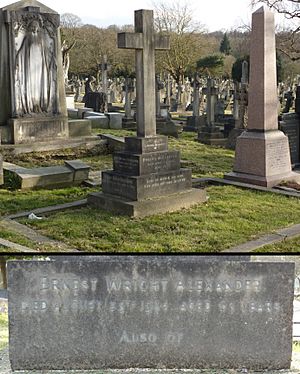Ernest Alexander facts for kids
Quick facts for kids
Ernest Wright Alexander
|
|
|---|---|
 |
|
| Born | 2 October 1870 Liverpool, England |
| Died | 25 August 1934 (aged 63) Kingsbridge, Devon, England |
| Buried |
Putney Vale Cemetery, London
(51°26′26″N 0°14′22″W / 51.440624°N 0.239389°W) |
| Service/ |
British Army |
| Years of service | 1889–1934 |
| Rank | Major-General |
| Unit | Royal Artillery |
| Battles/wars | |
| Awards | Mentioned in Despatches Knight of the Order of Savoy (Italy) Grand Officer of the Order of Aviz (Portugal) Croix de Guerre (France) |
Ernest Wright Alexander was a brave officer in the British Army. He was born on October 2, 1870, and passed away on August 25, 1934. He is most famous for receiving the Victoria Cross. This is the highest award given for incredible bravery in battle to British and Commonwealth soldiers.
Contents
Military Adventures
Starting His Career
Ernest Wright Alexander was born in Liverpool, England. His father was a director of the Suez Canal. Ernest went to Harrow School and then to the Royal Military Academy, Sandhurst. This is where he trained to become an army officer.
He joined the Royal Field Artillery as a second lieutenant in 1889. In 1892, he went to serve in India. He was promoted to lieutenant and then to captain. After returning to England, he went back to India for a few years. He became a major in 1906. Up to this point, his army journey was quite normal.
Heroism at Elouges
When the First World War began in August 1914, Major Alexander was serving in Belgium. He was part of a large army retreat.
On August 24, he showed amazing courage during a battle called the action of Elouges. He was in charge of the 119th Battery of the Royal Field Artillery. His unit was attacked by a much larger German force.
Even though the odds were against them, Major Alexander managed his guns so well that they were all saved. He and other volunteers, including Captain Francis Octavus Grenfell, pulled the heavy guns by hand. This brave act allowed the 5th Division to retreat safely without many losses. Later, Major Alexander also rescued a wounded soldier while under heavy enemy fire. For these actions, he was awarded the Victoria Cross.
Later War Service
Captain Grenfell also received the Victoria Cross for his bravery that day. Two of Alexander's sergeants earned the Distinguished Conduct Medal. Major Alexander's Victoria Cross was one of the first given out during the First World War.
His bravery led to quick promotions. Within a year of the Elouges battle, he became a brigadier-general. He was also honored with the title of Companion of the Order of St Michael and St George in 1915.
In 1916, he became the Brigadier General Royal Artillery for XV Corps. This unit played a big part in the First day on the Somme. Alexander planned very effective artillery barrages (lines of continuous gunfire). These helped XV Corps succeed in attacks at Fricourt and Mametz. His methods were so good that they were even written about in military history books. He kept improving his "creeping barrages," which were key to XV Corps' victory at the Battle of Bazentin Ridge.
In 1917, Alexander took command of the Royal Artillery for XI Corps. In April 1918, he was promoted again to major-general. He then commanded the Royal Artillery for the First Army. This promotion happened because the First Army's commander, General Sir Henry Horne, felt Alexander's work had helped him succeed earlier.
As the war ended, Major-General Alexander received more awards. He became a Knight of the Military Order of Savoy from Italy and a Companion of the Order of the Bath. He also received the French Croix de Guerre and was made a Grand Officer of the Military Order of Avis by Portugal. After the war, he commanded the Royal Artillery in the Southern Area of Aldershot Command.
Life After the War
After retiring from the army, Ernest Alexander became a deputy lieutenant for Devon in 1931. He passed away on August 25, 1934, in Kingsbridge, Devon, at the age of 63. He was buried at Putney Vale Cemetery.
His collection of medals, including his Victoria Cross, can be seen today. They are on display at the Ashcroft Gallery in the Imperial War Museum in London.


